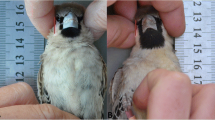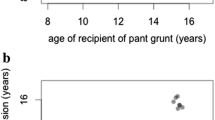Abstract
The status hierarchy is fundamental in the lives of male chimpanzees. This study describes the dominance interactions and social status among adult male chimpanzees of the Sonso community in the Budongo Forest Reserve, Uganda, during the period that they were first studied (1994 and 1995). Social dominance is typically measured using the behaviour of either the subordinate or the dominant individual, but a relationship is dependent on the behaviour of both parties and this study explicitly used both subordinate and dominant behaviours to investigate the status hierarchy. Among adult males of the Sonso community, agonistic interactions occurred at a low rate and pant-grunts were rare, but males could be ranked into separate hierarchies of agonistic dominance and pant-grunting (labelled ‘respect’) using ratios of behaviour performed/behaviour received. These hierarchies were combined to form a single hierarchy of social status that divided the males among five distinct status levels. The highest status level was held by an alliance between two males who replaced the previous alpha male during the first part of the study. Neither male in this alliance partnership pant-grunted to the other, although the reason for cooperative behaviour was unclear. Although the nominally beta male was treated as such by other adult males, he achieved surprisingly little mating success. Budongo Forest chimpanzees do not warrant the sometimes-expressed view that they are non-aggressive and peaceable and the broad pattern of their status interactions matches with that seen in other chimpanzee populations.

Similar content being viewed by others
References
Altmann J (1974) Observational study of behaviour: sampling methods. Behaviour 49:227–265
Appleby MC (1983) The probability of linearity in hierarchies. Anim Behav 31:600–608
Arnold K, Whiten A (2001) Post-conflict behaviour of wild chimpanzees (Pan troglodytes schweinfurthii) in the Budongo Forest, Uganda. Behaviour 138:649–690
Beilharz RG, Mylrea PJ (1963) Social position and behaviour of dairy heifers in yards. Anim Behav 11:523–533
Bernstein IS (1981) Dominance: the baby and the bathwater. Behav Brain Sci 4:419–458
Bernstein IS (2000) The dominance concept: causes and consequences. Am J Primatol 51:33
Boesch C, Boesch-Achermann H (2000) The chimpanzees of the Tai forest. Oxford University Press, Oxford
Bovet D, Washburn D (2001) Do rhesus macaques and chimpanzees have a dominance concept? Am J Primatol 54[Suppl 1]:88
Bradshaw JWS, Nott HMR (1995) Social and communication behaviour of companion dogs. In: Serpell J (ed)The domestic dog. Cambridge University Press, Cambridge, pp 115–130
Bygott JD (1979) Agonistic behaviour, dominance, and social structure in wild chimpanzees of the Gombe National Park. In: Hamburg DA, McCown ER (eds) The great apes. Benjamin/Cummings, Menlo Park, Calif., pp 405–428
Byrne RW (1995) The thinking ape: evolutionary origins of intelligence. Oxford University Press, Oxford
Byrne RW, Whiten A (1997) Machiavellian intelligence. In: Whiten A, Byrne RW (eds) Machiavellian Intelligence. II. Extensions and evaluations. Cambridge University Press, Cambridge, pp 1–23
Coelho AM, Turner SA, Bramblett CA (1983) Allogrooming and social status: an assessment of the contributions of female behaviour to the social organisation of hamadryas baboons (Papio hamadryas). Primates 24:184–197
Drews C (1993) The concept and definition of dominance in animal behaviour. Behaviour 125:283–313
Eggeling WJ (1947) Observations on the ecology of the Budongo Rain Forest, Uganda. J Ecol 34:20–87
Fawcett K, Muhumuza G (2000) Death of a wild chimpanzee community member: possible outcome of intense sexual competition. Am J Primatol 51:243–247
Fournier F, Festa-Bianchet M (1995) Social dominance in adult female mountain goats. Anim Behav 49:1449–1459
Fox MW, Bekoff M (1975) The behaviour of dogs. In: Hafez ESE (ed) The behaviour of domestic animals. Balliere Tindall, London, pp 370–409
Goodall J (1973) Cultural elements in a chimpanzee community. In: Menzel EW (ed) Precultural primate behaviour. Proceeding of the 4th IPC symposium. Karger Press
Goodall J (1986) The chimpanzees of Gombe: patterns of behaviour. Belknap, Cambridge, Mass.
Hasegawa T, Hiraiwa-Hasegawa M (1983) Opportunistic and restrictive mating among wild chimpanzees in the Mahale Mountains, Tanzania. J Ethol 1:75–85
Hayaki H (1990) Social context of pant grunting in young chimpanzees. In: Nishida T (ed) The chimpanzees of the Mahale Mountains. University of Tokyo Press, Tokyo, pp 189–206
Hayaki H, Huffman MA, Nishida T (1989) Dominance among male chimpanzees in the Mahale Mountains National Park, Tanzania: a preliminary study. Primates 30:187–197
Hemelrijk CK (1990) Models of, and tests for, reciprocity, unidirectionality and other social-interaction patterns at a group level. Anim Behav 39:1013–1029
Hinde RA (1976) Interactions, relationships and social structure. Man 11:42736
Hinde RA (1978) Dominance and role: two concepts with dual meanings. J Soc Biol Struct 1:27–38
Maslow A (1937) The role of dominance in social and sexual behaviour of infrahuman primates. 4. The determinants of a hierarchy in pairs and in a group. J Genet Psychol 49:161–198
Mason WA (1993) The nature of social conflict: a psycho-ethological perspective. In: Mason WA, Mendoza SP (eds) Primate social conflict. State University of New York Press, Albany, pp 13–47
Matsuzawa T (1990) Spontaneous sorting in humans and chimpanzees. In: Parker ST, Gibson KR (eds) Language and intelligence in monkeys and apes: comparative developmental perspectives. Cambridge University Press, Cambridge, pp 451–468
Muller MN (2002) Agonistic relations among Kanyawara chimpanzees. In: Boesch C, Hohmann G, Marchant LF (eds) Behavioural diversity in chimpanzees and bonobos. Cambridge University Press, Cambridge, pp 112–124
Newton-Fisher NE (1997) Tactical behaviour and decision making in wild chimpanzees. PhD thesis, University of Cambridge, Cambridge
Newton-Fisher NE (1999) Association by male chimpanzees: a social tactic? Behaviour 136:705–730
Newton-Fisher NE (2002) Relationships of male chimpanzees in the Budongo Forest, Uganda. In: Boesch C, Hohmann G, Marchant LF (eds) Behavioural diversity in chimpanzees and bonobos. Cambridge University Press, Cambridge, pp. 125–137
Nishida T (1968) The social group of wild chimpanzees in the Mahale Mountains. Primates 9:167–224
Nishida T (1997) Sexual behaviour of adult male chimpanzees of the Mahale Mountains National Park, Tanzania. Primates 38:379–398
Nishida T, Hosaka K (1996) Coalition strategies among adult male chimpanzees of the Mahale Mountains, Tanzania. In: McGrew WC, Marchant LF, Nishida T (eds) Great ape societies. Cambridge University Press, Cambridge, pp 114–134
Noë R, de Waal FBM, van Hoof J (1980) Types of dominance in a chimpanzee colony. Folia Primatol 34:90–110
Plumptre AJ (1996) Changes following 60 years of selective timber harvesting in the Budongo Forest Reserve, Uganda. For Ecol Manage 89:101–113
Power M (1991) The egalitarians: human and chimpanzee. Cambridge University Press, Cambridge, Mass.
Riss D, Goodall J (1977) The recent rise to the alpha-rank in a population of free-living chimpanzees. Folia Primatol 27:134–151
Rowell TE (1966) Hierarchy in the organisation of a captive baboon group. Anim Behav 14:430–443
Rowell TE (1974) The concept of social dominance. Behav Biol 11:131–154
Savage-Rumbaugh S, Lewin R (1994) Kanzi: the ape at the brink of the human mind. Doubleday, London
Simpson MJA (1973) The social grooming of male chimpanzees. In: Michael RP, Crook JH (eds) Comparative ecology and behaviour of primates. Academic, London, pp 411–506
Sugiyama Y, Koman J (1979) Tool-using and making behaviour of wild chimpanzees at Bossou, Guinea. Primates 20:323–339
Takahata Y (1990) Social relationships among adult males. In: Nishida T (ed) The chimpanzees of the Mahale Mountains: sexual and life history strategies. University of Tokyo Press, Tokyo, pp 133–148
Tutin CEG (1979) Mating patterns and reproductive strategies in a community of wild chimpanzees (Pan troglodytes schweinfurthii). Behav Ecol Sociol 6:29–38
Uehara S, Hiraiwa-Hasegawa M, Hosaka K, Hamai M (1994) The fate of defeated alpha male chimpanzees in relation to their social networks. Primates 35:49–55
Waal F de (1982) Chimpanzee politics: power and sex among apes. Jonathan Cape, London
Walters JR, Seyfarth RM (1987) Conflict and cooperation. In: Smuts BB, Cheney DL, Seyfarth RM, Wrangham RW, Struhsaker TT (eds) Primate societies. University of Chicago Press, Chicago, pp 306–317
Acknowledgements
I thank Dr. P.C. Lee for advice, support, and suggestions during this study. Dr. A.J. Plumptre and staff of the Budongo Forest Project, in particular G. Muhumuza, provided invaluable help in the field. Permission to live and work in the Budongo Forest Reserve was given by Prof V. Reynolds, and by the Uganda National Council for Science and Technology, the President’s Office, and the Forest Department. Core funding for the Budongo Forest Project was provided by the British Government’s Overseas Development Agency and the National Geographic Society. Data collection was supported by the L.S.B. Leakey Foundation, the L.S.B. Leakey Trust, the Boise Fund and Churchill College, Cambridge. Support during the writing of this paper came from the H.F. Guggenheim Foundation. I also thank the anonymous reviewers who commented on an earlier draft of this paper.
Author information
Authors and Affiliations
Corresponding author
About this article
Cite this article
Newton-Fisher, N.E. Hierarchy and social status in Budongo chimpanzees. Primates 45, 81–87 (2004). https://doi.org/10.1007/s10329-003-0064-6
Received:
Accepted:
Published:
Issue Date:
DOI: https://doi.org/10.1007/s10329-003-0064-6




